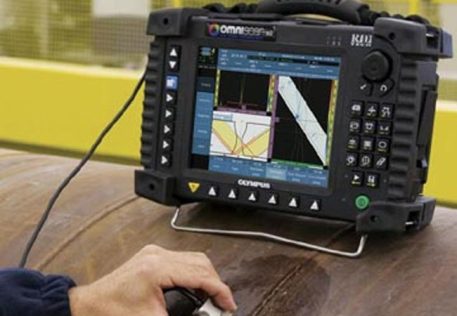Ultrasonic
We offer everything from Manual UT Thickness Readings, Phased Array Techniques to Advanced Manual Ultrasonic Flaw Detection and Sizing, Automated Ultrasonic Inspection, A-Scan, B-Scan, and C-Scan with Three Dimensional Viewing. We have Corrosion Mapping Systems and Weld Inspections Systems. Both Manual and Automated Systems are adaptable for Boiler Tubes, Pressure Vessels, Reactors, Columns, Critical Piping Systems, Plate, Tanks, Pipelines, and Specialized Systems.

How It Works
Ultrasonic inspection involves the transmission of ultra-high frequency sound waves through the part being tested and evaluating the reflected waves on a time delay oscilloscope.
It is useful for detecting sub-surface discontinuities, dimensional measurements (thickness) and analyzing material structure. In a typical pulse/echo ultrasonic inspection system, a transducer in contact with the test specimen generates high frequency ultrasonic energy that travels through the test specimen in the form of waves. The waves reflect back to the transducer off the opposite wall of the specimen. Any discontinuity in the path of the waves—a crack or inclusion, for example—will reflect part of the energy back to the transducer. The reflected wave is transformed into an electrical signal by the transducer and displayed on an oscilloscope. Typically, the strength of the reflected signal is plotted against the elapsed time from signal generation (pulse) to the moment the reflected signal (echo) is received. Signal travel times can be converted to the distance traveled, which can yield information on the location, size and orientation of the discontinuity.

Advantages
- Highly sensitive to both surface and sub-surface examinations
- Methods can provide both thickness measurement and flaw detection
- Superior depth of penetration
- Results are instantly available
- No environmental or safety hazard as is present with Radiography
- Regulatory requirement
- Only single side access required to perform test
Limitations
- Surface must be able to transmit ultrasound
- Skills and training of the ultrasonic technician are more extensive than other methods
- Discontinuities that are oriented parallel with the beam energy will usually not be detected
- Normally requires a coupling medium to provide transfer or sound energy
- Materials that are rough, irregular in shape are difficult to inspect
- Cast iron and coarse grain are difficult to inspect due to low sound transmission and big signal noise
- Reference standards are required for both equipment calibration and the characterization of flaws

